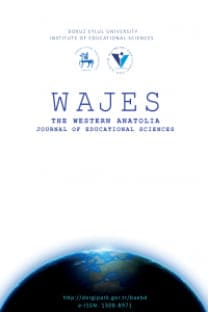Sınıf Öğretmenlerinin İş Karmaşıklığı Algılarının Uyum Sağlama Davranışlarını Gerçekleştirme Düzeyine Etkisi
Bu çalışmanın amacı sınıf öğretmenlerinin iş karmaşıklığı algıları ile uyum sağlama davranışlarınıgerçekleştirme düzeyleri arasındaki ilişkiyi incelemektir. Bu çalışmanın verileri 2014-‐‑2015 öğretimyılında Bolu ili merkez ilçe sınırları içerisinde yer alan ilkokullarda görev yapan 262 sınıf öğretmenindenelde edilmiştir. Araştırmanın verileri Morgeson ve Humphrey (2006) tarafından geliştirilen İş DizaynÖlçeği’nin iş karmaşıklığı faktörü ve öğretmenlerin uyum sağlama davranışlarını gerçekleştirmedüzeylerini belirlemek için ise Griffin et al. (2007) tarafından geliştirilen uyum sağlama beceri ölçeğikullanılarak elde edilmiştir. Verilerin analizinde aritmetik ortalama ve standart sapma, korelasyon veregresyon analizi kullanılmıştır. Araştırmada öğretmenlerin iş karmaşıklığı algıları ile uyum sağlamadavranışlarını gerçekleştirme düzeyleri arasında olumlu ve anlamlı ilişki bulunmuş ve işkarmaşıklığının, öğretmenlerin uyum sağlama davranışı göstermelerinin anlamlı bir açıklayıcısı olduğusaptanmıştır.
Anahtar Kelimeler:
İş karmaşıklığı, uyum sağalama davranışı, sınıf öğretmeni
The Effects of Perceives of Classroom Teachers’ Job Complexity on the Level of Performing Adaptive Behaviors
The purpose of the present study was to explore the relationship between perceives of classroomteachers’ job complexity and the level of performing adaptive behaviors. Data in this study werecollected from a total number of 262 classroom teachers. Classroom teachers’ perceives of job complexitywas measured using job complexity subscale of the work design questionnaire developed by Morgesonand Humphrey (2006) and the level of performing adaptive behaviors was measured using taskadaptivity scale developed by Griffin et al. (2007). Mean, standard deviation, correlation and regressiontest were used in analysis of data. Data analysis indicated that there was a significant positivelycorrelation between job complexity and the level of performing adaptive behaviors, and job complexitywas significantly predictor of the level of performing adaptive behaviors.
Keywords:
Job complexity, adaptive behavior, classroom teacher,
___
- Agarwal, A., Chuan, T.C., Jackson, S.A. & Mourshed, M. (2014). The future of Education. Outlook on the Global Agenda 2015. World Economic Forum. Armenakis, A.A. & Harris, S.G. (2009). Reflections: our journey in organizational change research and practice. Journal of Change Management, 9, 127-‐‑42. Bantwini, B.D. (2010). How teachers perceive the new curriculum reform: Lessons from a school district in the Eastern Cape provinee, South Africa. International Journal of Educational Development, 30, 83-‐‑90. Baek-‐‑Kyoo, J. & Lim, J. T. (2009). The effects of organizational learning culture, perceived job complexity, and proactive personality on organizational commitment and intrinsic motivation. Journal of Leadership and Organizational Studies, 16(1), 48-‐‑60. Berkovich, I. (2011). No we won’t! Teachers’ resistance to educational reform. Journal of Educational Administration, 49(5), 563-‐‑578. Cheng, Y.L. (2009). Hong Kong educational reforms in the last decade: Reform syndrome and new developments. International Journal of Educational Management, 23(1), 66-‐‑86. Davis, B. & Sumara, D. (2010). “If things were simple…”: Complexity in education. Journal of Evaluation in Clinical Practice, 16(4), 856-860. Ghitulescu, B. E. (2013). Making Change Happen: The Impact of Work Context on Adaptive and Proactive Behaviors. Journal of Applied Behavioral Science, 49(2), 206–245. Grebner, S., Semmer, N. K., Lo Faso, L., Gut, S., Kalin, W., & Elfering, A. (2003). Working conditions, well-‐‑being, and job-‐‑related attitudes among call centre agents. European Journal of Work and Organizational Psychology, 12, 341–365. Griffin, M., Neal, A., & Parker, S. (2007). A new model of work role performance: Positive behavior in uncertain and interdependent contexts. Academy of Management Journal, 50, 327-‐‑347. Griffin, M., Parker, S., & Mason, C. (2010). Leader vision and the development of adaptive and proactive performance: A longitudinal study. Journal of Applied Psychology, 95, 174-‐‑ 182. Hornung, S., & Rousseau, D. (2007). Active on the job–proactive in change: How autonomy at work contributes to employee support for organizational change. Journal of Applied Behavioral Science, 43, 401-‐‑426. Hsiao, H.C. & Chang, J.C. (2011). The role of organizational learning in transformational leadership and organizational innovation. Asia Pacific Education Review, 12, 621-‐‑631. Humphrey, S., Nahrgang, J., & Morgeson, F. (2007). Integrating motivational, social, and contextual work design features: A meta-‐‑analytic summary and theoretical extension of the work design literature. Journal of Applied Psychology, 92, 1332-‐‑1356. Kysilka, M.L., Geary, M. & Schepise, S. (2002). The Complexity of teaching in the information age school. Curriculum and Teaching Dialogue, 4(1), 59-‐‑65. Liu, P. & Li, Z. (2012). Task complexity: A review and conceptualization framework. International Journal of Industrial Ergonomics, 42, 553-‐‑568. Mohd-‐‑Sanusi, Z. & Mohd-‐‑Iskandar, T. (2007). Audit judgment performance: Assessing the effect of performance incentives, effort and task complexity. Managerial Auditing Journal, 22(1), 34-‐‑52. Marz, U. & Kelchtermans, G. (2013). Sense-‐‑making and structure in teachers’ reception of educational reform: A case study on statistics in the mathematics curriculum. Teaching and Teacher Education, 29, 13-‐‑24. Morgeson, F., & Humphrey, S. (2006). The work design questionnaire (WDQ): Developing and validating a comprehensive measure for assessing job design and the nature of work. Journal of Applied Psychology, 91, 1321-‐‑1339. Pulakos, E., Arad, S., Donovan, M., & Plamondon, K. (2000). Adaptability in the workplace: Development of a taxonomy of adaptive performance. Journal of Applied Psychology, 85, 612-‐‑624. Prieto, S.M. & Perez-‐‑Santana, M. P. (2014). MAnaging innovative work behavior: The role of human resource practices. Personnel Review, 43(2), 184-‐‑208. Sadler-‐‑Smith, E., Spicer, D.P. & Chaston, A. (2001). Learning orientations and growth in smaller firms. Long Range Planning, 34, 139-‐‑158. Smith, T.M., & Desimone, L.M. (2003). Do changes in patterns of participation inteachers’ professional development reflect the goals of standards-‐‑based reform? Education Horizons 119–129. Sturman, M.C., Cheramie, R.A. & CAshen, C.H. (2005). The Impact of job complexity and performance measurement on the temporal consistency, stability, and test-‐‑retest reliability of employee job performance ratings. Journal of Applied PSychology, 90(2), 269-‐‑ 283. Van Den Heuvel, M., Demerouti, E., Bakker, A.B. & Schaufeli, W.B. (2013). Adapting to change: The value of change information and meaning-‐‑making. Journal of Vocational Behavior, 83, 11-‐‑21.
- Yayın Aralığı: Yılda 2 Sayı
- Başlangıç: 2010
- Yayıncı: Dokuz Eylül Üniversitesi
Sayıdaki Diğer Makaleler
Müzik Öğretmen Adaylarının Epistomolojik İnançları
